Five
Copies in Context: The Coronation of Charles V in His Grandes Chroniques de France
Anne D. Hedeman
Until recently, scholars studying the French coronation concentrated for the most part on textual problems posed by the ordines and discussed representations of the ceremony only in passing.[1] Art historians have begun to fill that lacuna by focusing on two areas of research. Claire Sherman's masterful analysis of the pictures and text of the queen's ordo in Charles V's Coronation Book (London, B.L., Ms. Cotton Tiberius B. VIII) exemplifies the first, which could be termed a monographic approach. Sherman took as a point of departure an analysis of the relationship between text and image of the ordo in Charles V's Coronation Book . This analysis enabled her to demonstrate ways in which themes that were sharpened in the revised text of the ordo were supported and strengthened in the pictorial cycle that decorated the king's copy of the text. She broadened her study to show that the emphasis on fertility and stress on the importance of the French house that shaped the text and illustrations of the Coronation Book had a place within the broader context of Charles V's commissions and responded to contemporary historical events.[2] Robert Scheller's study of narrative genres in representations of the French coronation exemplifies a second, synthetic approach to the study of images of coronation. In his study, Scheller, through an analysis of pictures of French coronations from such diverse sources as ordines and histories, isolated three broad genres of illustration: factually narrative, condensed, and emblematic images. He defined factually narrative illustrations as those that isolate each ceremonial moment of the coronation in an individual scene. Cycles containing these pictures are rare; the most elaborate example is Charles V's Coronation Book . More common are condensed scenes that encapsulate the ceremony in a single image that represents such easily recognized features of the ceremony as the presence of the peers, or emblematic scenes that represent the coronation in the guise of symbols of the monarchy.
Scheller cautioned that the selection of a narrative, condensed, or emblematic representation was independent of the decision to paint the scene in a particular artistic style. Increased naturalism of representation would not necessarily guarantee increased historical accuracy; thus condensed scenes could be painted in the highly naturalistic style of Jean Fouquet, and detailed factually narrative scenes in the less naturalistic style of the master of Charles V's Coronation Book .[3]
A major strength of Scheller's and Sherman's studies lies in the care with which they establish a context for the image. Sherman considered the illustrations of the Coronation Book within the narrow framework of the book itself and then within the broader cultural context of the court of Charles V, whereas Scheller analyzed representations of coronations within the dual contexts of genres of narrative and of artistic styles. In some ways their approaches seem to be mutually exclusive—Sherman's grounded in the analysis of one book and Scheller's in a comparative examination of many books. However their methods can—and, I hope to demonstrate, must—be united in order to deal with a particular class of images: medieval copies. To show how these approaches can be blended I will analyze one copy of the Coronation Book , a manuscript that both Scheller and Sherman found to be exceptional. Among questions to consider are the following. What happens when illustrations of an important text like the Coronation Book are copied? Do pictures that imitate images from the Coronation Book have the same historical content that Sherman described for the prototype? If the original image is, as Scheller suggested, factually narrative, would the copy be as well? Or might the copy be a condensed or emblematic scene belonging to a different narrative genre? To what extent would a scene based on a picture from the Coronation Book illustrate the ordo, and to what degree would it illustrate the new text? To explore some of these questions, I will consider as a case study one of the better-known copies after Charles V's Coronation Book —the illustration selected to represent Charles V's coronation in his personal copy of the Grandes Chroniques de France (Paris, B.N. ms. fr. 2813). An analysis of this picture suggests that copies do form a special class of image which often functions in a different narrative genre and which must be considered within the dual contexts of the text that generated it and the text that it accompanies.
The scene that introduces the narrative of Charles V's life is one of the most perlexing miniatures in his Grandes Chroniques de France (fig. 5.1).[4] Historians and art historians alike have dismissed the double miniature of the king and queen enthroned from serious consideration because it copied earlier images.[5] Paradoxically, it is precisely this dependence that makes the scene representing Charles's coronation special. Of the 175 pictures in this manuscript, it is the only derivative miniature, a status that raises questions about its function in the Grandes Chroniques .
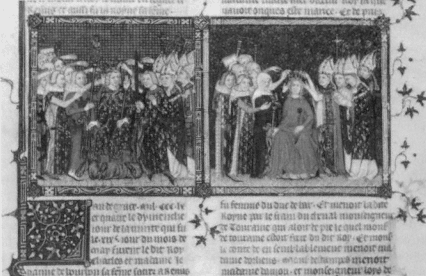
Figure 5.1.
Peers supporting the crowns at the coronations of Charles V and Jeanne
of Bourbon, Grandes Chroniques de France, Paris, B.N., ms. fr. 2813, fol. 439,
c. 1375–1377.
In order to understand its importance, the picture of Charles V and Jeanne of Bourbon must be considered within the specific context of Charles V's manuscript. This image was painted between 1375 and 1377 to decorate a continuation of the Grandes Chroniques which was written at court. The continuation updated a previously completed manuscript that contained texts written at the monastery of St. Denis chronicling the history of the French kings from their Trojan origins through the reign of Philip of Valois.[6] The new continuation, describing the reign of John the Good and part of Charles V's reign, ended in a chapter that discussed two events of 1375: the publication in Parlement of the ordinance regulating the majority of the French kings and the forging of a treaty with the English at Bruges. Charles V's Grandes Chroniques did not exist long in this form; in 1379 or 1380 the manuscript was updated by a second continuation and by illustrated substitutions that replaced select older texts. With these changes the manuscript effectively took the shape it has today.
These circumstances of production make Charles V's book unique among copies of the Grandes Chroniques . Twice it was finished and presumably placed in the royal library, and twice it was removed so that texts and pictures could be added in order to update the history of the Valois dynasty and the reigning king.[7] Many of the images that decorate these added texts are large in
scale and particularly detailed. Most of them are unique to Charles V's manuscript and respond closely to contemporary politics and to Charles's concern with the legitimacy and the continuity of his line in the face of a rival claim to the throne by the king of England supported by the king of Navarre.[8]
The first continuation written at court between 1375 and 1377 provides the specific context for the miniature of Charles V and Jeanne of Bourbon (fig. 5.1). This image introduces the account of Charles V's reign and draws special attention to that king and to his queen. The ceremony portrayed here differs in detail from those in the manuscript that mark the commencement of other kings' reigns, exemplified here by the Coronation of John the Good (fig. 5.2), a miniature painted in the same campaign as the double scene of Charles V and Jeanne of Bourbon. Thus Charles grasps a scepter representing Charlemagne enthroned that is still preserved in the Louvre, and Jeanne of Bourbon holds in her right hand the scepter of Dagobert, now lost but known from eighteenth-century drawings by Montfaucon.[9]
Scholars have explained the specificity of this particular picture by citing its models—images from Charles V's commemorative Coronation Book (figs. 5.3 and 5.4).[10] The Coronation Book , produced in 1365 under Charles V's direct supervision, was decorated by the same workshop that later painted the double picture in the Grandes Chroniques . Because it formed part of the royal library, the Coronation Book was an authoritative and convenient model for the images in the Grandes Chroniques . The relationship to the Coronation Book provides a plausible explanation for the compositional similarity between these images, but it makes their differences in heraldry, to be discussed below, even more problematic.
Also puzzling is the moment chosen to illustrate the beginning of Charles V's reign. Instead of the moment of coronation, the picture represents a portion of the ceremony that occurred after the coronation proper—a symbolic expression of support for the new king and queen by the clerical and lay peers. The text of the chronicle does not describe the ceremony of coronation in sufficient detail to mention this action by the peers of France. Indeed, the Grandes Chroniques recounts simply that the king and queen were crowned, and it lists some of the nobles in attendance.[11] Strictly speaking, the miniatures of the coronations of Charles V and of Jeanne of Bourbon from the Coronation Book would have been more appropriate models if the only goal of this picture in the Grandes Chroniques were commemoration.[12]
The placement of the queen next to the king in the chronicle suggests that these images played a fundamentally different role in Charles V's Grandes Chroniques than they did in his Coronation Book . The double miniature in the Grandes Chroniques juxtaposes two pictures that were separated by eleven folios and by as many miniatures in the Coronation Book . In reality, the ceremony of the queen's coronation was begun only after that of the king was
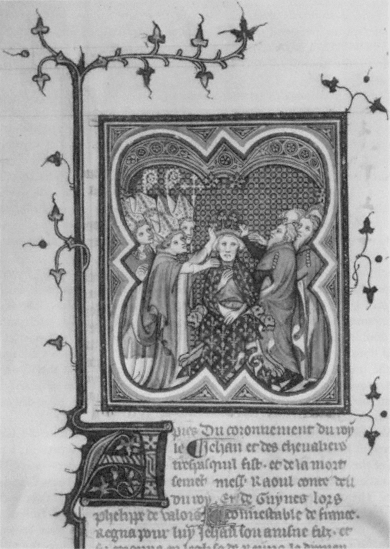
Figure 5.2.
Coronation of John the Good, Grandes Chroniques de France
Paris, B.N., ms. fr. 2813, fol. 393, c. 1375–1377.
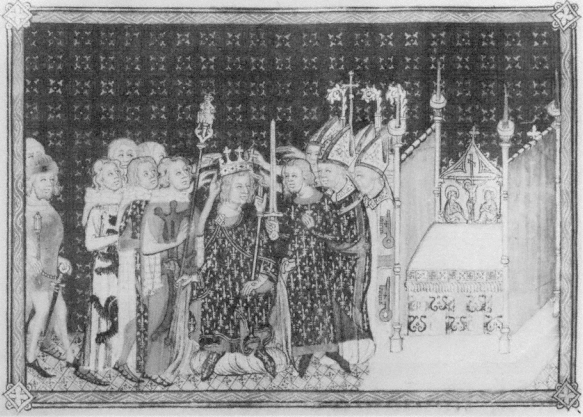
Figure 5.3.
Peers supporting the crown of Charles V, Coronation Book, London, B.L.,
Cottonian Ms. Tiberius B. VIII, fol. 59v, c. 1365.
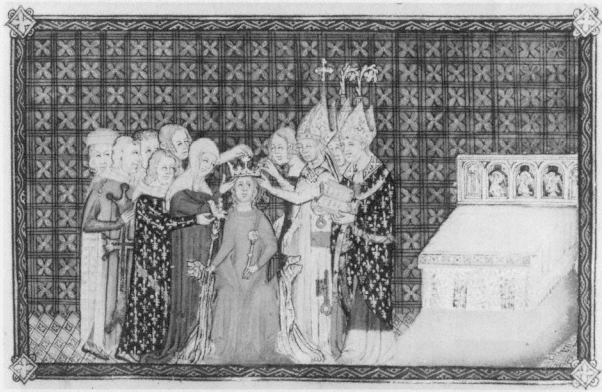
Figure 5.4.
Peers supporting the crown of Jeanne of Bourbon, Coronation Book,
London, B.L., Cottonian Ms. Tiberius B. VIII, fol. 70, c. 1365.
finished. The representation in the Grandes Chroniques of parallel moments from two ceremonies glosses over the temporal separation between them. This telescoping of two distinct events gives more prominence to the queen; it presents her on an almost-equal footing with the king.
Compositional changes also transcend the specific historical events of the coronation of 1364. The double miniature of the Grandes Chroniques does not contain the altars that established in the Coronation Book that the ceremony took place in an ecclesiastical setting. This change makes the double miniature from the Grandes Chroniques more secular than its model from the Coronation Book .[13]
This comparison of the double miniature of support in the Grandes Chroniques with its text and with the illustrations of the Coronation Book raises three basic questions. Why was the heraldry changed? Why was the queen included in Charles's book? And what significance does the selection of the moment of support have, considering that a model depicting the precise moment of coronation was also available?
As will become clear, a consideration of the double image within the specific context of Charles V's manuscript and the more generalized context of contemporary historical events provides answers for some of these questions. Such a consideration demonstrates that the change of heraldry between the model of 1365 and the copy of 1375–1377, the inclusion of the queen, and the choice of a moment of support rather than coronation reflect the dual function of the picture: it was both a commemoration of the events of 1364 and an expression of Charles V's concerns for a smooth transition of power upon his death.
The double miniature in Charles V's chronicle combines into one image two scenes from the Coronation Book . In the first, an image from the sequence of pictures dedicated to the king's coronation (fig. 5.3), the king is flanked by the count of Flanders, the duke of Bourbon, the count of Toulouse, the duke of Anjou, the archbishop of Reims, and the bishop of Beauvais. In the second, a miniature from the ceremony of the queen's coronation (fig. 5.4), the queen is flanked by the count of Toulouse, the count of Étampes, the bishop of Beauvais, and the archbishop of Reims.[14]
The positions of three people changed when these scenes were copied in the Grandes Chroniques (fig. 5.1). In the scene showing the peers supporting the crown after the coronation of the queen, the duke of Burgundy replaced the count of Flanders and the duke of Bourbon replaced the count of Étampes.[15] In the scene with the king, the count of Étampes takes the position near the king that the duke of Bourbon held in the Coronation Book .
These careful heraldic changes do not increase the historical accuracy of the picture. Of the peers distinguished by heraldry in the miniatures, the Grandes Chroniques describe as present only the archbishop of Reims; the bishop of Beauvais; Louis, duke of Anjou; and Philip the Bold, duke of
Burgundy.[16] Although not mentioned specifically in the text of the chronicle, the count of Étampes, the count of Flanders, and the duke of Bourbon were peers at the time of the coronation; they were listed as such in both Charles V's Coronation Book and in the conflicting list of peers that appeared in the Traité du sacre , the commentary on the ceremony of coronation commissioned by Charles from Jean Golein in 1374.[17]
Two of the peers included in these pictures may only have been represented by proxy. Although the county of Toulouse had reverted to the throne by the time of Charles V's reign, it is possible that Charles appointed someone to represent this ancient peerage. Chronicles are silent on this point for Charles V's coronation, but representation by proxy was a practice in the coronations of Charles VII in 1429 and for subsequent kings.[18] If scholars are correct in asserting that Louis of Male, count of Flanders, did not attend Charles's coronation, it may be that he too was represented by a proxy.[19]
Whether the presence of the counts of Flanders and Toulouse in the pictures of the Grandes Chroniques and the Coronation Book represents reality or a fiction is not germane to this discussion since the counts appear in both manuscripts. More intriguing are the differences between images in these books: the introduction of the duke of Burgundy into the scene of support for the queen and the change of positions of the duke of Bourbon and the count of Étampes in order to place the duke of Bourbon close to the queen.
Since the dukes of Bourbon and Burgundy and the count of Étampes were present at the coronation, pictorial or written accounts of the ceremony cannot explain discrepancies between these pictures. Charles V's concerns for the education of his heir may explain them. Charles V's first child, who became Charles VI, was born in 1368 during the period between the execution of the Coronation Book and the Grandes Chroniques de France . The birth of a son which had been eagerly anticipated for eighteen years assured the continuity of the Valois line. To safeguard the continuity, Charles V promulgated three ordinances in 1374.[20] One, concerned with the age of majority, was published in the Parlement of Paris in 1375 and was the subject of the last chapter of Charles V's life in this copy of the Grandes Chroniques . It thus closed the reign that began with the scene of the peers' support. In many ways the ordinance on the majority was a logical ending for the chronicle when this version of the manuscript was written and painted between 1375 and 1377 while Charles V was still king. Although it did not complete Charles V's life, it did provide a plan for a smooth transition to his son's government.
A consideration of the two ordinances of 1374 that were written simultaneously with the ordinance on majority, yet were not discussed in the chronicle, sheds light on the miniature in the Grandes Chroniques . The first ordinance established that Charles's brother, Louis, duke of Anjou, would become regent in the event that Charles died before his son reached his
majority. The second may be more significant for understanding the heraldic changes. It charged Jeanne of Bourbon with the education and upbringing of her children and provided her with two major assistants: her brother-in-law, Philip the Bold, duke of Burgundy, and her brother Louis, duke of Bourbon. The association of Philip and Louis with the queen in this special charge must have been sufficient motivation for their inclusion with her in the picture in this manuscript and could be one reason why the scene with the queen was placed by the king's in the first place—to demonstrate visually the provisions for legitimate government.
The choice of a moment of support rather than coronation may also reflect Charles V's concerns with providing a smooth transition to the government of his heirs. A contemporary text, the Traité du sacre by Jean Golein, provides insights into the significance of the peers' gestures in the ceremony.[21] Completed in the same year as the ordinance on government and contemporary with the painting of the miniature in the Grandes Chroniques , Golein's treatise glossed the events of the coronation with an explanation of their symbolic meaning. In his treatise Golein stressed frequently the peers' role in assisting in the just government of France. The portion of the Traité du sacre which described the moment of the ceremony represented in the Grandes Chroniques emphasized the peers' role as defenders of king and realm. According to Golein, "the peers surround the king to signify the forces who surround Solomon, all of them expert with the sword, skilled in battle, because if they [the peers] are not presently holding their swords, they are nearby to be taken when it is time to defend the king and realm."[22] Perhaps dual images of baronial support were included here to show that the peers were ready to defend their present king (Charles V) and to uphold the government of his descendants—a government in which the queen and the peers flanking her were supposed to play an important role.
On the most basic level then, this picture is a special commemoration of Charles V's and of Jeanne of Bourbon's coronations in 1364. As such, it derives its iconography from the official commemorative manuscript of the coronation. However, this commemorative function may be less important than a second function that emerges when the picture is considered within the context of the Grandes Chroniques as they existed in 1375–1377, after the continuation of the first half of Charles V's reign was added to the book. Within this specific context the picture simultaneously introduces Charles V's reign and alludes to the conclusion of it—to the provisions for government under the young dauphin and to the peers' duty to protect and defend the realm and their king, no matter what his age.
While some may question the validity of this interpretation, support for it is found in an analysis of the baptismal procession (fig. 5.5), the only other large picture of ceremonial from the version of Charles's life that existed in 1375–1377.[23] The theme of dynastic continuity to which the miniature of
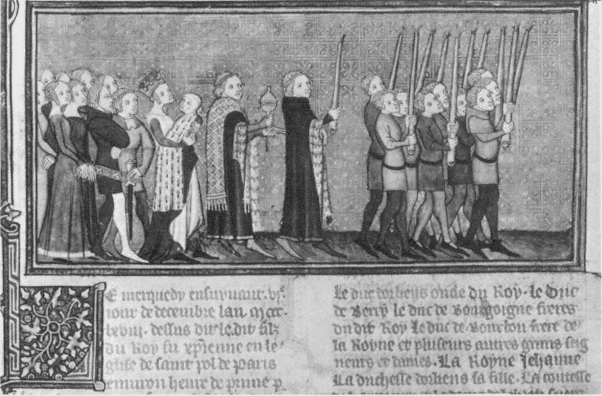
Figure 5.5.
Baptism procession of Charles VI, Grandes Chroniques de France, Paris, B.N., ms. fr. 2813, fol. 446v, c. 1375–1377.
baronial support only alludes is amplified in the representation of the procession that took place in 1368 when Charles's firstborn son was christened. An important part of the ceremony described in the text and highlighted in this image is the role played by queen Jeanne d'Evreux, the last wife of the last Capetian king. Her role carrying the Valois heir must have been seen at the time as an affirmation of the continuity of Capetian to Valois—of the sanction of the Capetian kings for their Valois successors. These two images of ceremonial, coronation and baptism, that are unique to this special copy of the Grandes Chroniques de France combine in a sophisticated way with the chronicle's text and with each other to focus on the past and future of the Valois line. In so doing, they provide us with insight into Charles's concerns at a precise moment in history.
Neither the illustrations for the Grandes Chroniques nor those from the Coronation Book take precedence as accurate representations of history. As a result historians have frequently dismissed them and described the miniature in the Grandes Chroniques as a replica of the pictures in the Coronation Book . By expecting these images to be pictorial documents, truthful or unchanging in a twentieth-century sense, they misunderstood their function, which in the chronicle depends on a subtle interaction between picture and text.
It is striking that pictures like the scenes of support from the Coronation Book and Grandes Chroniques are so close in appearance yet are put to such different uses. Within the context of the Coronation Book , images depend on the ordo that they supplement, but do not transcend.[24] The scenes of support for the king and queen there are essentially commemorative; they are part of a serial illustration of the ceremony of coronation, sequentially ordered in both space and time. Perhaps because they are removed from the text of the ordo that generated them, the same compositions serve a different purpose in the Grandes Chroniques . In that book the double miniature of the king and queen compresses the time that elapsed between the moments of support in the actual ceremony, a passage of time physically experienced by the reader of the Coronation Book when he turned the ten folios to proceed from one event to the other. This compression gives singular importance to the queen, particularly in a chronicle where no other events from queens' coronations are reproduced in pictures.[25] In the Grandes Chroniques the double miniature does not depend on the text it accompanies. Indeed, its primary meaning only emerges with the reconstruction of its position in the book in 1375–1377. Then it becomes evident that the double miniature simultaneously commemorated a past event and looked forward to the future. At the very least in these scenes of support, the alteration of heraldry updated the model to place near the queen those peers who were especially trusted in 1375–1377. I suspect that the motivation for the changes related more closely to the structure of the chronicle itself. I believe that the placement of this double miniature makes an explicit reference to provisions for succession partially discussed in
the text which in 1375–1377 ended the life of Charles V in the Grandes Chroniques .
This double miniature is more than a representation or a misrepresentation of fact. It does not expand in any way on knowledge about the ceremony of coronation despite the inclusion of realia . Instead, the image associates disparate portions of the chronicle. It and other large images of ceremonial like it are ways of particularizing this special copy of the Grandes Chroniques de France and of focusing on Charles V's preoccupation with the continuity of the Valois line.